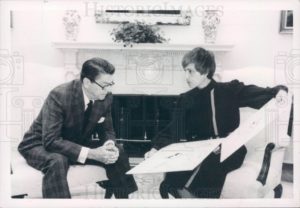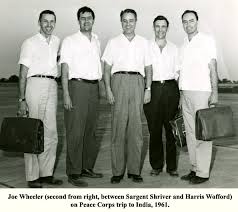Remembering the 25th Anniversary RPCV Conference (Washington, D.C.)
The 25th anniversary conference was one of the most remarkable events in the history of the Peace Corps. If you were fortunate enough to be in Washington, D.C., in September 1986, you were one of approximately 5,000 RPCVs who had served in 94 countries who took part in the event, much of it within the largest tent ever raised on The Mall, at the foot of the Capitol Dome adjacent to the Air and Space Museum.
The tent was the brainchild of Bill Carey (Bolivia 1965-68), who left a Congressional job to become executive director of the conference. The tent was born of necessity. Other facilities of sufficient size had already been reserved.
David Schickele (Nigeria 1961-63) would later write, “That tent was like the Peace Corps I was part of in 1961-63. Its muggy windless flaps said something about heat and hard work and improvisation, its massive nonchalance the perfect protection for the ideas being hatched beneath it.”
Roger Landrum (Nigeria 1961-63), a major force in creating the 25th Anniversary Conference, as president of the DC RPCV group, ran into trouble immediately with the Peace Corps. The agency didn’t want any kind of RPCV reunion. They won’t support it.
Peace Corps Director Loret Miller Ruppe and her gang of political appointees were afraid of a crowd of RPCVs gathered in D.C., fearing the RPCVs would march on the White House and against President Reagan. However, Ruppe and her lackeys had to back off when Harris Wofford secured for the RPCVs a grant of $25,000 from the MacArthur Foundation to stage the conference. Seeing that it would happen–with or without her–Ruppe rushed to elbow her way onto the RPCV stage.
She arranged for Philippines President Corazon Aquino to speak on the Mall, and scheduled a Saturday event at the Kennedy Center hosted by Harry Belafonte, as well as, a White House reception for the first Volunteers to go overseas.
Ruppe also hired Milton Viorst to edited a collection of essays about the Peace Corps entitled, Making A Difference: The Peace Corps At Twenty-Five with a foreword by President Ronald Reagan.
But the reunion was a Volunteer event–as the Peace Corps really is about PCVs, not Washington HQ staff–and the purpose of the agency was brought into focus when Shriver rose at the end of the day on Saturday to greet the crowd and address the RPCVs. It was a vintage Shriver performance.
Sarge was 70 at the time. As he stood to give the final speech of the day, everyone stood to greet him with sustained applause. Years after his time as the first director, even to the recent RPCVs who had never met him, Shriver was the legend of the Peace Corps.
He began by talking about how the Peace Corps was put together in the first days of the Kennedy Administration, and even in the far corners of the tent, the crowd was silent and attentive as he spoke of how this unique government idea of service became a reality.
This is part of what Sarge had to say.
“No one in 1961 would have predicted that the Peace Corps would last five years, let alone 25. Most of us hoped to get approval from just one Congress and survive to the next Congress. We never had a multi-year authorization. Every year was do or die. And every year more than 25 percent of the United States Congress voted against us. We had famous enemies….some Democrats, as well as Republicans, were skeptical. I wasn’t even able to convince my law school classmate, Jerry Ford, to support Peace Corps. We weren’t accepted like apple pie and motherhood.
“Nevertheless, we were nervy and presumptuous. Can you believe that we had 400 volunteers overseas at work before Congress ever approved the Peace Corps! In fact, we didn’t have a nickel from Congress. Jack Kennedy let us use his ‘discretionary fund.’ And he was ‘discrete’ enough to give us enough to hire our entire staff, select and train the first volunteers, ship them overseas, and arrange all our operations in seven countries without approval from anybody! Today no one could do that politically.
“We started the Peace Corps without knowing whether anybody in the world wanted it. Retrospectively, I think that took a little bit of chutzpah. We went on the road like any other traveling salesman. We visited our potential customers. We should remember with affection and respect that the host nations gambled with us. Their leaders had the courage to trust what we were saying. That proved that Peace Corps has always been a two-way street.
“The name of our organization, ‘Peace Corps,’ was bitterly contested. ‘Peace Corps’ was not the most popular title. The experienced government officials preferred ‘The Agency For Overseas Voluntary Service.” Conservatives were opposed to the world ‘peace.’ They maintained that the name was too wishy-washy, and that the communists had corrupted the word ‘peace’ by applying it to every political initiative and war they go involved in. The left wing disliked the word ‘corps.’ They said it sounded militaristic. Finally, I decided to use both words. ‘Peace’ because that was truly our business, and “Corps’ because it showed we were not individualistic, but a group.
He then restated his admiration for what we had done in the developing world, in persons and by deed, and what we symbolized to the people of the world. “The miracle is,” he said, “that decades of war, Presidential prevarication and disgrace, budget cutting, and the cynicism of power politics still have not killed the dream nor staunched the flow of those willing to volunteer and serve. All of you made the Peace Corps a success.”
“PCVs know what they are doing with their hands as well as with their hearts. Their courage, their generosity, their spirit tells the world what American democracy, rather than American power, is all about.”
And summing up, he quoted his familiar and famous call to service. “Be servants of peace,” said Sarge. “Work at home as you have worked abroad, humbly, persistently, intelligently. Weep with those who are sorrowful. Rejoice with those who are sick. Join others who serve. Serve, serve, serve. That’s the challenge. For in the end it will be the servants who save us all.”


It indeed was a wonderful event. Our small Somali RPCV group was blessed with the attendance of one of us who had moved to Canada and came down by motorcycle, with his dog “Liberty” in a basket on the back and a Somali flag rolled up in his knapsack.
In my opinion, you are too hard on Loret. It was after all, a Republican administration. By arranging for President Aquino to speak and holding an event at the Kennedy Center, she heightened the favorable publicity for Peace Corps. It is impossible to calculate how much goodwill that engendered in Congress but those are the people who voted on the PC budget. She should not have opposed the 25th in the first place but I applaud her for making the Agency, RPCVs and PCVs in the field more visible.
I was hard on her, but I also spoke to her about her position (and mine), at another reunion. She had a tough go in the job as so many of Reagan’s administration wanted to close the agency down. She kept it going and by the end of her tour—the longest tour of any Director–she was behind the movement to make sure an RPCV was always selected to be Director. She would also say that the 24 hours of readings by RPCVs that NPCA President Tim Carroll arranged in the Capital on the anniversary of JFK’s assassination generated more positive news accounts and publicity for the agency than any other Peace Corps event. So, RPCVs do know what’s best for the Peace Corps.
Thanks for the reminder, John. I was privileged to attend the 25th Reunion in Washington, DC. It was wonderful to see so many returned PCV’s and Staff there and we all marched across the bridge to the JFK Memorial on a beautiful summer day.
Cynthia Scott Francisco (staff wife, Ethiopia 63-65)
The article said a reception was held at the White House for the first groups of volunteers to go overseas. Actually it was a luncheon held at one of the Senate buildings attended by the Vice-President Bush, Sargent Shriver, and Senator Ted Kennedy.
John, I’m trying to get a high resolution image of the tent on the mall during the 25th anniversary event. I was there, but my photos, alas, just focused on me and my family. If you have a high res image of that photo, or other photos from 1986, could you send them to me? It’s for the PC documentary A Towering Task.
— Bob Shaw (Jamaica X RPCV)